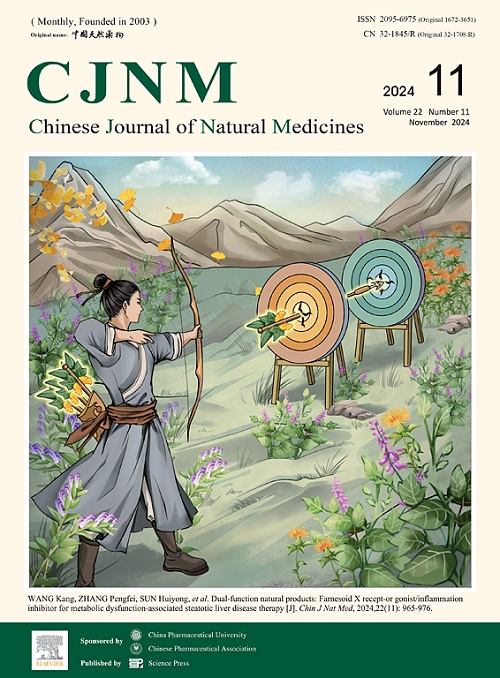荆芥种子中结构新颖的色胺衍生生物碱及其对呼吸道合胞病毒的抗病毒活性
IF 4.9
2区 医学
Q1 INTEGRATIVE & COMPLEMENTARY MEDICINE
引用次数: 0
摘要
骆驼蓬(Peganum harmala L.)是一种重要的经济药用植物。哈玛拉籽已被广泛应用于中药、维吾尔药和蒙药中,并被列入中国卫生部《药品标准》。从苦参种子中分离到12个新的色胺衍生生物碱(1 ~ 12)和8个已知化合物(13 ~ 20)。化合物1和2代表了首次报道的色胺衍生异构体,分别由色胺和苯胺片段组成,它们分别具有先前未记载的C-3−N-1 ‘连接和C-3−C-4 ’连接。化合物3 ~ 5被鉴定为吲哚-喹唑啉异构体,在吲哚和喹唑啉衍生的片段之间具有新的C-3和NH-1 '键。化合物6显示了C-C连接的色胺-喹唑啉二聚体的二聚化模式。化合物8是一种由色胺衍生的异二聚体,具有独特的碳骨架,具有不寻常的螺旋三环(7)和常规双环色胺。化合物9 ~ 11为新型的6/5/5/5螺-四环色胺衍生生物碱,呈现出独特的色胺-螺-吡咯利嗪环体系。化合物1−3和6−11被鉴定为外消旋物。化合物2、7、9、10和12通过x射线晶体学分析得到证实。所有分离的化合物(1 ~ 20)对呼吸道合胞病毒(RSV)表现出不同程度的抗病毒作用。化合物12的抗rsv活性(IC50为5.01±0.14 μmol·L−1)优于阳性对照(利巴韦林,IC50为6.23±0.95 μmol·L−1),经斑块减少和免疫荧光实验验证。从苦参种子中分离出抗rsv化合物,可促进其抗病毒药物的开发和应用。本文章由计算机程序翻译,如有差异,请以英文原文为准。
Structurally novel tryptamine-derived alkaloids from the seeds of Peganum harmala and their antiviral activities against respiratory syncytial virus
Peganum harmala L. (P. harmala) is a significant economic and medicinal plant. The seeds of P. harmala have been extensively utilized in traditional Chinese medicine, Uighur medicine, and Mongolian medicine, as documented in the Drug Standard of the Ministry of Health of China. Twelve novel tryptamine-derived alkaloids (1−12) and eight known compounds (13−20) were isolated from P. harmala seeds. Compounds 1 and 2 represent the first reported instances of tryptamine-derived heteromers, comprising tryptamine and aniline fragments with previously undocumented C-3−N-1′ linkage and C-3−C-4′ connection, respectively. Compounds 3−5 were identified as indole-quinazoline heteromers, exhibiting a novel C-3 and NH-1′ linkage between indole and quinazoline-derived fragments. Compound 6 demonstrates the dimerization pattern of C-C linked tryptamine-quinazoline dimer. Compound 8 represents a tryptamine-derived heterodimer with a distinctive carbon skeleton, featuring an unusual spiro-tricyclic ring (7) and conventional bicyclic tryptamine. Compounds 9−11 constitute novel 6/5/5/5 spiro-tetracyclic tryptamine-derived alkaloids presenting a unique ring system of tryptamine-spiro-pyrrolizine. Compounds 1−3 and 6−11 were identified as racemates. Compounds 2, 7, 9, 10, and 12 were confirmed via X-ray crystallographic analysis. All isolated compounds (1−20) exhibited varying degrees of antiviral efficacy against respiratory syncytial virus (RSV). Notably, the anti-RSV activity of compound 12 (IC50 5.01 ± 0.14 μmol·L−1) surpassed that of the positive control (ribavirin, IC50 6.23 ± 0.95 μmol·L−1), as validated through plaque reduction and immunofluorescence assays. The identification of anti-RSV compounds from P. harmala seeds may enhance the development and application of this plant in antiviral therapeutic products.
求助全文
通过发布文献求助,成功后即可免费获取论文全文。
去求助
来源期刊

Chinese Journal of Natural Medicines
INTEGRATIVE & COMPLEMENTARY MEDICINE-PHARMACOLOGY & PHARMACY
CiteScore
7.50
自引率
4.30%
发文量
2235
期刊介绍:
The Chinese Journal of Natural Medicines (CJNM), founded and sponsored in May 2003 by China Pharmaceutical University and the Chinese Pharmaceutical Association, is devoted to communication among pharmaceutical and medical scientists interested in the advancement of Traditional Chinese Medicines (TCM). CJNM publishes articles relating to a broad spectrum of bioactive natural products, leading compounds and medicines derived from Traditional Chinese Medicines (TCM).
Topics covered by the journal are: Resources of Traditional Chinese Medicines; Interaction and complexity of prescription; Natural Products Chemistry (including structure modification, semi-and total synthesis, bio-transformation); Pharmacology of natural products and prescription (including pharmacokinetics and toxicology); Pharmaceutics and Analytical Methods of natural products.
 求助内容:
求助内容: 应助结果提醒方式:
应助结果提醒方式:


